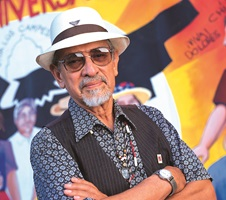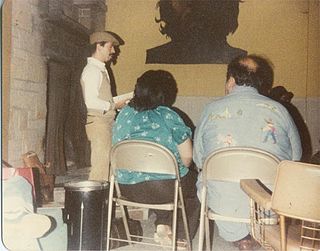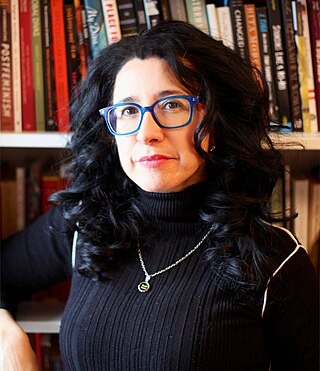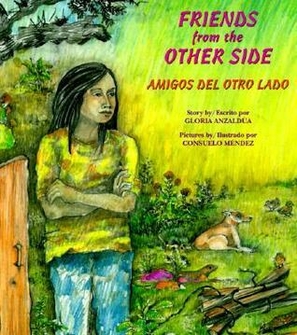
Sandra Cisneros is an American writer. She is best known for her first novel, The House on Mango Street (1983), and her subsequent short story collection, Woman Hollering Creek and Other Stories (1991). Her work experiments with literary forms that investigate emerging subject positions, which Cisneros herself attributes to growing up in a context of cultural hybridity and economic inequality that endowed her with unique stories to tell. She is the recipient of numerous awards, including a National Endowment for the Arts Fellowship, was awarded one of 25 new Ford Foundation Art of Change fellowships in 2017, and is regarded as a key figure in Chicano literature.

José Montoya was a poet and an artist from Sacramento, California. He was one of the most influential Chicano bilingual poets. He has published many well-known poems in anthologies and magazines, and served as Sacramento's poet laureate.

Tomás Rivera was a Mexican American author, poet, and educator. He was born in Texas to migrant farm workers, and worked in the fields as a young boy. However, he achieved social mobility through education—earning a degree at Southwest Texas State University, and later a Doctor of Philosophy degree (PhD) at the University of Oklahoma—and came to believe strongly in the virtues of education for Mexican-Americans.

Norma Elia Cantú is a Chicana postmodernist writer and the Murchison Professor in the Humanities at Trinity University in San Antonio, Texas.

Alberto Baltazar Urista Heredia, better known by his nom de plume Alurista, is an American poet and activist. His work was influential in the Chicano Movement and is important to the field of Chicano poetry.

Chicano poetry is a subgenre of Chicano literature that stems from the cultural consciousness developed in the Chicano Movement. Chicano poetry has its roots in the reclamation of Chicana/o as an identity of empowerment rather than denigration. As a literary field, Chicano poetry emerged in the 1960s and formed its own independent literary current and voice.
Alicia Gaspar de Alba is an American scholar, cultural critic, novelist, and poet whose works include historical novels and scholarly studies on Chicana/o art, culture and sexuality.

Romeo Rolando Hinojosa-Smith was an American novelist, essayist, poet and the Ellen Clayton Garwood professor in the English Department at the University of Texas at Austin. He was noted for authoring the Klail City Death Trip series of 15 novels written over several decades.

Mexican American literature is literature written by Mexican Americans in the United States. Although its origins can be traced back to the sixteenth century, the bulk of Mexican American literature dates from post-1848 and the United States annexation of large parts of Mexico in the wake of the Mexican–American War. Today, as a part of American literature in general, this genre includes a vibrant and diverse set of narratives, prompting critics to describe it as providing "a new awareness of the historical and cultural independence of both northern and southern American hemispheres". Chicano literature is an aspect of Mexican American literature.

Carmen Lomas Garza is an Chicana artist and illustrator. She is well known for her paintings, ofrendas and for her papel picado work inspired by her Mexican-American heritage. Her work is a part of the permanent collections of the Smithsonian American Art Museum, the Hirshhorn Museum and Sculpture Garden, the National Museum of Mexican Art, the San Jose Museum of Art, the Mexican Museum, the Pennsylvania Academy of the Fine Arts, and the Oakland Museum of California, among other institutions.
The National Association for Chicana and Chicano Studies (NACCS) is "the academic organization that serves academic programs, departments and research centers that focus on issues pertaining to Mexican Americans, Chicana/os, and Latina/os." Unlike many professional academic associations, NACCS "rejects mainstream research, which promotes an integrationist perspective that emphasizes consensus, assimilation, and legitimization of societal institutions. NACCS promotes research that directly confronts structures of inequality based on class, race and gender privileges in U.S. society." The association is based in San Jose, California.

Lorna Dee Cervantes is an American poet and activist, who is considered one of the greatest figures in Chicano poetry. She has been described by Alurista as "probably the best Chicana poet active today."
Alma Luz Villanueva is an American poet, short story writer, and novelist.
Julian S. Garcia has been involved in Chicano literature since the late 1970s when the San Antonio arts and politics journal Caracol had its offices on West Commerce Street in San Antonio, Texas. In 1985, Garcia became one of Caracol's associate editors. He was also an Associate editor of ViAztlan, an international journal of ideas and philosophy. A deconstructionist with a penchant for Aristotelian logic and a mentor to Tejano writers, Garcia has a written articles and editorials under a nom-de-plume.

Deborah Paredez is an American poet, scholar, and cultural critic. She is the author of the poetry collections, Year of the Dog and This Side of Skin, and the critical study, Selenidad: Selena, Latinos, and the Performance of Memory. She is co-founder of CantoMundo, a national organization that supports Latinx poets and poetry. She lives in New York City where she is a professor of creative writing and ethnic studies at Columbia University.

Friends from the Other Side / Amigos del Otro Lado (1993) is a bilingual (Spanish/English) Latino children's book written by Mexican American/Chicana scholar Gloria E. Anzaldúa and illustrated by Consuelo Méndez Castillo. It is loosely based on Anzaldúa's early life in South Texas and tells the story of a young Chicana girl, Prietita, living near the US-Mexican border who befriends and helps a young Mexican boy, Joaquín, who has recently immigrated.
Santa Barraza is an American mixed-media artist and painter who is well known for her colorful, retablo style painting. A Chicana, Barraza pulls inspiration from her own mestiza ancestry and from pre-Columbian art. Barraza is considered to be an important artist in the Chicano art movement. The first scholarly treatment of a Chicana artist is about her and is called Santa Barraza, Artist of the Borderlands, which describes her life and body of work. Barraza's work is collected by the Mexic-Arte Museum, and other museums around the United States and internationally. She currently lives in Kingsville, Texas.

Xavier Garza is an author and illustrator of children's books and professor of art at Northwest Vista College in San Antonio.
Laurie Ann Guerrero is a Chicana poet from San Antonio, Texas. She was the poet laureate of San Antonio from 2014 to 2016 and the Poet Laureate of Texas from 2016 to 2017. In the fall semester of 2017, she became the first writer-in-residence at Texas A&M University San Antonio and a "fully immersed faculty member. She will teach a contemporary American woman poets course, host numerous University writing workshops and mentor students while working on her next writing project."
Adela Sloss-Vento was born Karnes City, Texas to Anselma Garza and David Henry Sloss. As a young American woman of Mexican descent, she was determined to become a writer, hailing from southern Texas, educated in San Juan, later lived in Corpus Christi during World War II, and then settled in Edinburg, she used her pen as weapon for more than sixty years, countering racial discrimination and exploitation of laborers, all the while championing the civil rights of Mexican Americans through the written word.













